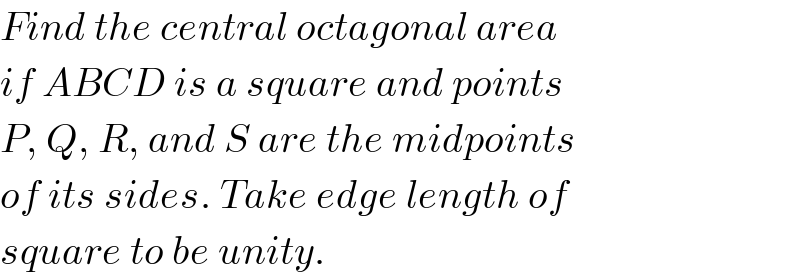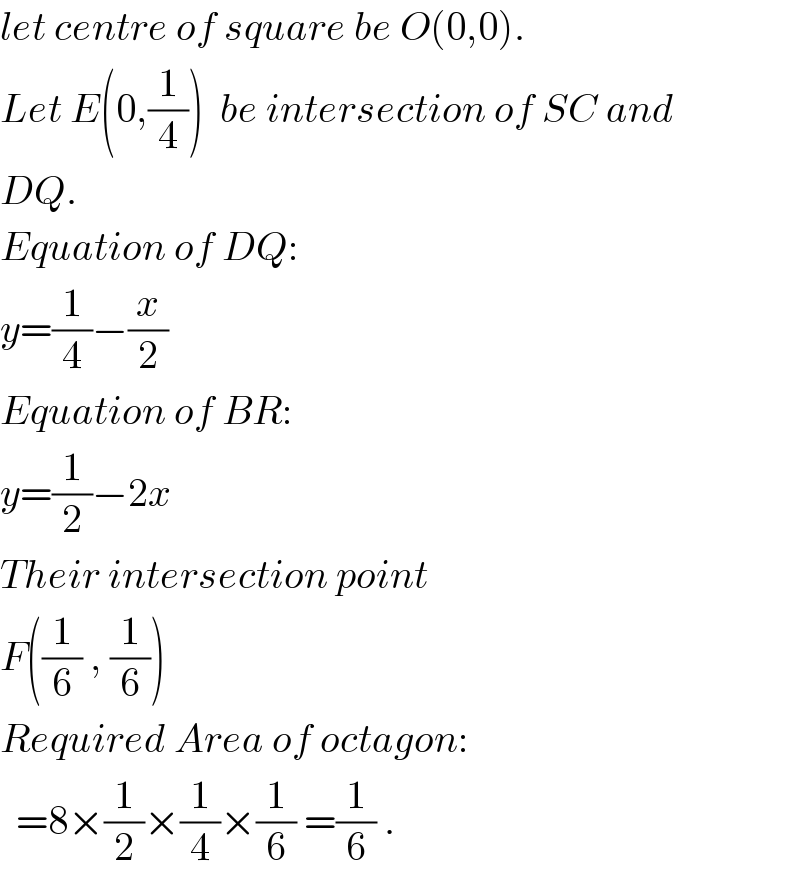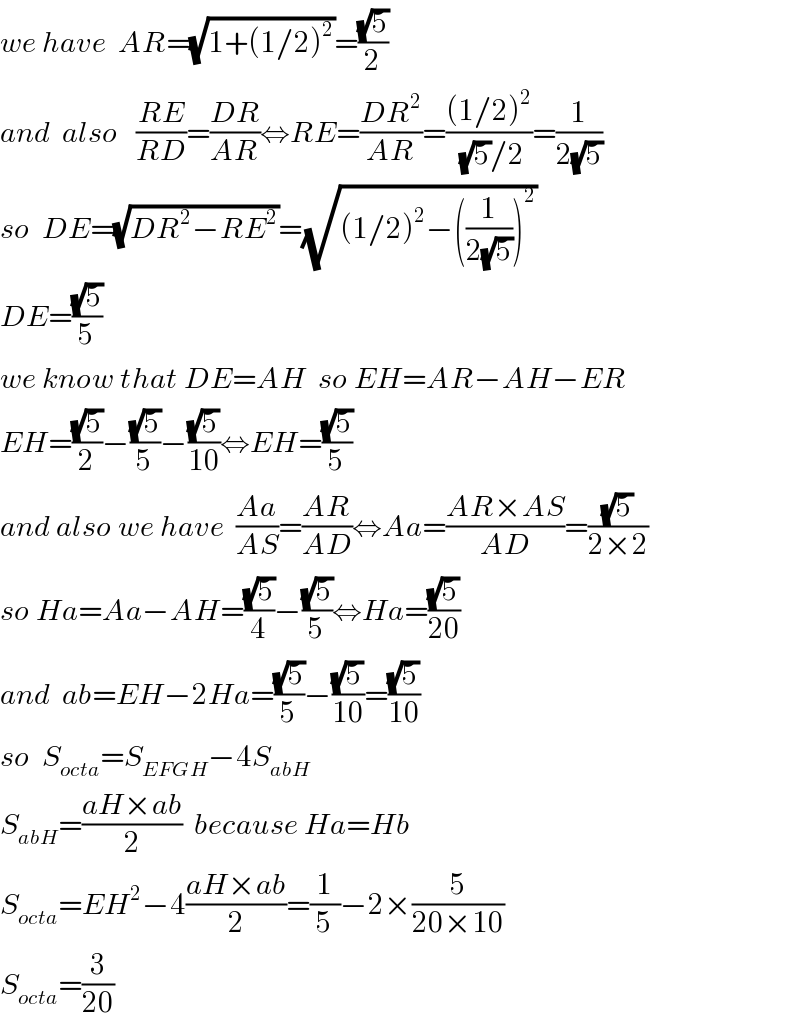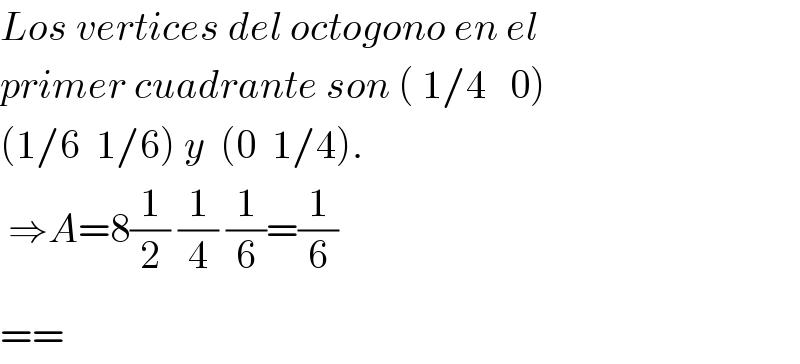
Question Number 24605 by ajfour last updated on 22/Nov/17

Commented by ajfour last updated on 22/Nov/17

$${Find}\:{the}\:{central}\:{octagonal}\:{area} \\ $$$${if}\:{ABCD}\:{is}\:{a}\:{square}\:{and}\:{points} \\ $$$${P},\:{Q},\:{R},\:{and}\:{S}\:{are}\:{the}\:{midpoints} \\ $$$${of}\:{its}\:{sides}.\:{Take}\:{edge}\:{length}\:{of} \\ $$$${square}\:{to}\:{be}\:{unity}. \\ $$
Answered by ajfour last updated on 22/Nov/17

$${let}\:{centre}\:{of}\:{square}\:{be}\:{O}\left(\mathrm{0},\mathrm{0}\right). \\ $$$${Let}\:{E}\left(\mathrm{0},\frac{\mathrm{1}}{\mathrm{4}}\right)\:\:{be}\:{intersection}\:{of}\:{SC}\:{and} \\ $$$${DQ}. \\ $$$${Equation}\:{of}\:{DQ}: \\ $$$${y}=\frac{\mathrm{1}}{\mathrm{4}}−\frac{{x}}{\mathrm{2}} \\ $$$${Equation}\:{of}\:{BR}: \\ $$$${y}=\frac{\mathrm{1}}{\mathrm{2}}−\mathrm{2}{x} \\ $$$${Their}\:{intersection}\:{point}\: \\ $$$${F}\left(\frac{\mathrm{1}}{\mathrm{6}}\:,\:\frac{\mathrm{1}}{\mathrm{6}}\right) \\ $$$${Required}\:{Area}\:{of}\:{octagon}: \\ $$$$\:\:=\mathrm{8}×\frac{\mathrm{1}}{\mathrm{2}}×\frac{\mathrm{1}}{\mathrm{4}}×\frac{\mathrm{1}}{\mathrm{6}}\:=\frac{\mathrm{1}}{\mathrm{6}}\:. \\ $$
Commented by jota last updated on 22/Nov/17

$${Los}\:{vertices}\:{sobre}\:{la}\:{diagonal}\: \\ $$$${estan}\:{a}\:\:\sqrt{\mathrm{2}}/\mathrm{6}\:{del}\:{centro}\:{O}. \\ $$
Answered by sma3l2996 last updated on 22/Nov/17

$${we}\:{have}\:\:{AR}=\sqrt{\mathrm{1}+\left(\mathrm{1}/\mathrm{2}\right)^{\mathrm{2}} }=\frac{\sqrt{\mathrm{5}}}{\mathrm{2}} \\ $$$${and}\:\:{also}\:\:\:\frac{{RE}}{{RD}}=\frac{{DR}}{{AR}}\Leftrightarrow{RE}=\frac{{DR}^{\mathrm{2}} }{{AR}}=\frac{\left(\mathrm{1}/\mathrm{2}\right)^{\mathrm{2}} }{\sqrt{\mathrm{5}}/\mathrm{2}}=\frac{\mathrm{1}}{\mathrm{2}\sqrt{\mathrm{5}}} \\ $$$${so}\:\:{DE}=\sqrt{{DR}^{\mathrm{2}} −{RE}^{\mathrm{2}} }=\sqrt{\left(\mathrm{1}/\mathrm{2}\right)^{\mathrm{2}} −\left(\frac{\mathrm{1}}{\mathrm{2}\sqrt{\mathrm{5}}}\right)^{\mathrm{2}} } \\ $$$${DE}=\frac{\sqrt{\mathrm{5}}}{\mathrm{5}} \\ $$$${we}\:{know}\:{that}\:{DE}={AH}\:\:{so}\:{EH}={AR}−{AH}−{ER} \\ $$$${EH}=\frac{\sqrt{\mathrm{5}}}{\mathrm{2}}−\frac{\sqrt{\mathrm{5}}}{\mathrm{5}}−\frac{\sqrt{\mathrm{5}}}{\mathrm{10}}\Leftrightarrow{EH}=\frac{\sqrt{\mathrm{5}}}{\mathrm{5}} \\ $$$${and}\:{also}\:{we}\:{have}\:\:\frac{{Aa}}{{AS}}=\frac{{AR}}{{AD}}\Leftrightarrow{Aa}=\frac{{AR}×{AS}}{{AD}}=\frac{\sqrt{\mathrm{5}}}{\mathrm{2}×\mathrm{2}} \\ $$$${so}\:{Ha}={Aa}−{AH}=\frac{\sqrt{\mathrm{5}}}{\mathrm{4}}−\frac{\sqrt{\mathrm{5}}}{\mathrm{5}}\Leftrightarrow{Ha}=\frac{\sqrt{\mathrm{5}}}{\mathrm{20}} \\ $$$${and}\:\:{ab}={EH}−\mathrm{2}{Ha}=\frac{\sqrt{\mathrm{5}}}{\mathrm{5}}−\frac{\sqrt{\mathrm{5}}}{\mathrm{10}}=\frac{\sqrt{\mathrm{5}}}{\mathrm{10}} \\ $$$${so}\:\:{S}_{{octa}} ={S}_{{EFGH}} −\mathrm{4}{S}_{{abH}} \\ $$$${S}_{{abH}} =\frac{{aH}×{ab}}{\mathrm{2}}\:\:{because}\:{Ha}={Hb} \\ $$$${S}_{{octa}} ={EH}^{\mathrm{2}} −\mathrm{4}\frac{{aH}×{ab}}{\mathrm{2}}=\frac{\mathrm{1}}{\mathrm{5}}−\mathrm{2}×\frac{\mathrm{5}}{\mathrm{20}×\mathrm{10}} \\ $$$${S}_{{octa}} =\frac{\mathrm{3}}{\mathrm{20}} \\ $$
Commented by sma3l2996 last updated on 22/Nov/17

Answered by jota last updated on 22/Nov/17

$${Los}\:{vertices}\:{del}\:{octogono}\:{en}\:{el} \\ $$$${primer}\:{cuadrante}\:{son}\:\left(\:\mathrm{1}/\mathrm{4}\:\:\:\mathrm{0}\right)\:\: \\ $$$$\left(\mathrm{1}/\mathrm{6}\:\:\mathrm{1}/\mathrm{6}\right)\:{y}\:\:\left(\mathrm{0}\:\:\mathrm{1}/\mathrm{4}\right). \\ $$$$\:\Rightarrow{A}=\mathrm{8}\frac{\mathrm{1}}{\mathrm{2}}\:\frac{\mathrm{1}}{\mathrm{4}}\:\frac{\mathrm{1}}{\mathrm{6}}=\frac{\mathrm{1}}{\mathrm{6}} \\ $$$$=\overset{} {=} \\ $$
Commented by ajfour last updated on 22/Nov/17

$${Thank}\:{you}\:{too}\:{much}. \\ $$
